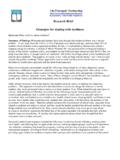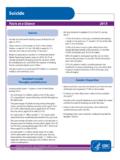Transcription of 2011 Survey of Pathways to Diagnosis and Services ...
1 National Center for Health Statistics State and Local Area Integrated Telephone Survey Frequently Asked Questions 2011 Survey of Pathways to Diagnosis and Services Updated April 24, 2012 The 2011 Survey of Pathways to Diagnosis and Services ( Pathways ) is a nationally representative Survey about children with special health care needs (CSHCN) aged 6 to 17 years old ever diagnosed with autism spectrum disorder (ASD), intellectual disability, or developmental delay. The questions and answers below summarize key information about the Pathways Survey , which is a follow-up Survey to the 2009-2010 National Survey of Children with Special Health Care Needs (NS-CSHCN). A detailed report on the design and operation of the Pathways Survey is forthcoming and will be released online as soon as possible.
2 The design of the 2009-2010 NS-CSHCN is similar to the 2001 NS-CSHCN and the 2005-2006 NS-CSHCN. Detailed descriptions of the design and operation of these surveys, as well as descriptions of the publicly available data files and data editing procedures, are published online ( ). Similar detail for the 2009-2010 NS-CSHCN is not yet available. However, a Frequently Asked Questions document for the 2009-2010 NS-CSHCN has been posted online ( ) that highlights changes made to the design and administration of the Survey . Users of the Pathways Survey data are encouraged to review these documents. The present document highlights general information that is unique to the Pathways Survey design. Please read this document before analyzing the Pathways data.
3 BACKGROUND Who sponsored the 2011 Pathways Survey ? The National Institute of Mental Health (NIMH) of the National Institutes of Health (NIH), with funds available from the American Recovery and Reinvestment Act of 2009 (ARRA) (Public Law 111-5). The Survey is part of NIMH s Pathways to Diagnosis and Services Study. Who conducted the 2011 Pathways Survey ? CDC s National Center for Health Statistics (NCHS), State and Local Area Integrated Telephone Survey (SLAITS) program. SAMPLE DESIGN What was the 2011 Pathways sample design? Follow-up Survey to the 2009-2010 NS-CSHCN, which was a cross-sectional random-digit-dial telephone Survey (landlines and cell phones) of US households with at least one child aged 0 to 17 years at the time of the interview.
4 A sample of children with special health care needs (CSHCN) identified as having (or having had) at least one of three developmental conditions (ASD, intellectual disability, and/or developmental delay) was randomly selected from the NS-CSHCN. Their parents and guardians were re-contacted by telephone for the Pathways interview. Parents and guardians who completed the telephone interview were then sent a self-administered questionnaire (SAQ) by mail. Parents and guardians who had not returned the SAQ received a reminder telephone call to prompt completion; some parents and guardians completed the SAQ over the phone at that time. Because the Pathways Survey follows the NS-CSHCN, it shares the complex Survey design of the NS-CSHCN, with clustering of children within households and stratification by state and sample type (landline or cell phone).
5 In addition, the random selection of Pathways -eligible children for follow-up was stratified by condition(s) reported in the NS-CSHCN. 2 How was eligibility determined? Telephone numbers for the randomly selected Pathways -eligible CSHCN were called and screened to ensure that the children still met all four eligibility criteria: o The respondent who completed the 2009-2010 NS-CSHCN was available to be interviewed for the Pathways interview. o The Pathways -eligible child was 6 to 17 years of age at the time of the Pathways interview. o The Pathways -eligible child continued to live in the same household as the respondent. o The respondent for the 2009-2010 NS-CSHCN confirmed or reported that a doctor or other health care provider had ever said that the child had ASD, intellectual disability, and/or developmental delay.
6 If the child no longer met all of the above eligibility criteria, the call was terminated. If the telephone number no longer reached the expected NS-CSHCN respondent, additional efforts were made to try to locate the respondent by 1) calling any available telephone numbers for the respondent or alternate contact that were provided during the NS-CSHCN, and 2) performing extensive searches using various Internet sites. If the information did not lead to the NS-CSHCN respondent, the case was deemed not locatable. How many children were selected as the target of the interview? The targeted number of completed interviews was 4,000. To attain the target number of interviews, 6,090 cases out of 7,572 eligible cases were sampled from the 2009-2010 NS-CSHCN.
7 QUESTIONNAIRE What is the content of the Pathways Survey ? The Pathways Survey consists of both a telephone interview and an SAQ. Both instruments are available online at The telephone interview asked respondents about the emergence of symptoms, the context of the original diagnoses, the providers who made the diagnoses, the child s current diagnostic status, the types of clinical treatments/interventions and educational Services used to address the developmental problems, and other parental concerns or perspectives. The SAQ consists of questions about current symptomatology and impairment levels, as well as children s skills and abilities. What is the source of the Pathways Survey questions? Most of the Pathways Survey questions were developed especially for the Survey to meet various data needs.
8 However, the questionnaire does include several question sets drawn from other sources. For example: o Questions on the doctor s response to the parent s concerns (PC7_A), early intervention Services (ES10-ES11), and functional limitations (FSD1) were used in the Pennsylvania Autism Needs Assessment (Bureau of Autism Services , Pennsylvania Department of Public Welfare, 2011). o Questions on the receipt of standardized, parent-completed developmental screening (PC7_B-PC7_F) were developed by the Child and Adolescent Health Measurement Initiative (Bethell et al., 2011) and originally used on the 2007 National Survey of Children s Health. o Questions on parental perceptions (PP2) were adapted from the Revised Illness-Perception Questionnaire modified for autism (IPQ-RA; Anbar et al.)
9 , 2010). o The SAQ includes the 25-item Strengths and Difficulties Questionnaire (Goodman, 1997) in Parts A-C, and the telephone questionnaire includes the brief 5-item SDQ as fielded annually in CDC s National Health Interview Survey . The copyrighted 25-item SDQ permits users to develop generalized scores for conduct problems, hyperactivity, emotional symptoms, peer problems, and pro-social behavior. It also includes questions related to chronicity, distress, social impairment, and burden to others. 3 o The SAQ also includes the Children s Social Behavior Questionnaire (Hartman et al., 2006) in Part D. This 49-item questionnaire, adapted (with permission of the author) for use with English-speaking US parents, can be used to describe the severity and pattern of social deficits and other behaviors characteristic of children with ASD, especially in ASD s milder forms.
10 NCHS is in the process of confirming the validity of scales based on these adapted questions for this population of school-aged US children. DATA COLLECTION When were the data collected? Pathways telephone interviewing began on February 10, 2011 and ended on May 15, 2011. The data collection period for the SAQ was from March 8, 2011 through June 21, 2011. Who was the respondent? The parent or guardian with knowledge of the health and health care of the children in the household who originally completed the 2009-2010 NS-CSHCN detailed interviews. Of these respondents, 80% were the mother (biological, step, foster, or adoptive), 14% were the father (biological, step, foster, or adoptive), and 6% were some other relative or guardian. What was the average interview length?


















